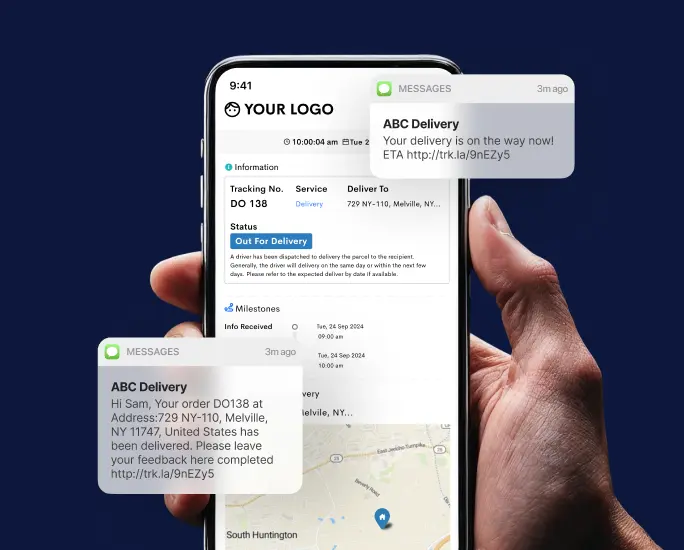In delivery businesses, time is money. Yet, a common practice—idling—often goes under the radar, affecting your profits. As a delivery business owner, you’re probably wondering: how much gas idling use, and what’s the real impact on your budget and operations?
In this blog, we’ll dive into the unique challenges that idling poses for delivery businesses. We’ll explore its environmental and financial consequences and offer practical solutions to help you cut down on idling, improving your bottom line and sustainability.
Join us as we unveil the hidden costs of idling in the delivery world.
What is Truck Idling?
Truck idling refers to keeping a truck’s engine running when the vehicle is not in motion. This often occurs when the truck is parked, waiting, or temporarily stopped.
It serves various purposes, such as maintaining a comfortable cabin temperature for the driver, which is crucial during extreme weather conditions. Idling can also be necessary during mandated rest periods when drivers must sleep in the truck’s cabin.
Additionally, some trucks require idling to power onboard equipment like refrigeration units for transporting perishable goods, ensuring they remain at the proper temperature. Idling is also used to keep the engine readily available for quick starts, a valuable feature in time-sensitive delivery operations.
However, it’s important to note that while idling serves essential functions, it can lead to increased fuel consumption, higher operational costs, and environmental concerns due to emissions. As a result, finding ways to reduce unnecessary idling is a priority for the trucking industry.
Reasons Why Trucks Idle
Comfort & Convenience
Truck drivers often idle to maintain a comfortable cabin temperature, especially during extreme weather conditions. This practice ensures that drivers can work, rest, and sleep in a climate-controlled environment, promoting safety and well-being on the road.
It’s not just about comfort; it’s also about reducing the risk of hypothermia in cold weather and heat-related illnesses in hot conditions.
However, with advancements in auxiliary power units and improved insulation in modern trucks, there are more efficient ways to provide this comfort without excessive idling.
Waiting for Loading/Unloading
Idling is common during the wait times at loading docks and waiting for cargo to be loaded or unloaded.
It’s a precaution to keep the engine ready for immediate departure, especially in temperature-sensitive delivery operations.
However, with technology and practices that optimize loading and unloading processes, there’s room for reducing idling during these waiting periods.
Electrical Needs
Some trucks require idling to power onboard electrical equipment, such as refrigeration units, tools, or appliances. This ensures that the equipment functions properly and meets operational requirements.
Many modern trucks offer alternative power sources to address this need while minimizing idling, such as auxiliary power units and shore power connections at truck stops.
This can significantly reduce the environmental and financial costs associated with idling.
Fear of Engine Strain
Drivers might idle their trucks out of concern for the engine. Some believe frequently turning off and restarting the engine can cause more wear and tear than maintaining a consistent idle.
While there is a grain of truth to this concern, modern engines are designed to handle frequent startups, and technological advancements have reduced the impact of wear and tear.
Balancing engine health with fuel efficiency is key.
Traffic Conditions
In heavy traffic, truck drivers may choose to idle rather than frequently starting and stopping the engine. Frequent engine restarts can be fuel-intensive and lead to increased engine wear.
However, newer engine designs and technologies have made quick restarts more efficient.
Additionally, improved traffic management and route planning can help reduce the need for excessive idling during traffic congestion.
Mandatory Rest Breaks
Regulations often require truck drivers to take mandatory rest breaks to prevent driver fatigue and improve road safety.
During these breaks, idling can power the cabin’s amenities, such as air conditioning, heating, and appliances.
However, these regulations encourage idle-reduction technologies to maintain comfort without excessive engine idling, promoting driver well-being and environmental sustainability.
Lack of Awareness of Regulatory Guidelines
Some drivers may idle their trucks due to a lack of awareness or understanding of regulatory guidelines that limit idling.
Education and awareness programs can help reduce unnecessary idling by informing drivers about the environmental and financial consequences of excessive idling and the specific regulations to mitigate these impacts.
Engine Warm Up
In cold weather, drivers may idle to allow the engine to warm up, ensuring optimal performance and reliability before hitting the road. However, modern engines often require less warm-up time than older models.
Idling for extended periods for engine warm-up is becoming less necessary as technology and engineering have made today’s engines more efficient and capable of functioning effectively even in colder conditions.
Pre-trip inspections and maintenance ensure the engine is ready for the road without excessive idling.

What Costs Are Involved with an Idle Truck?
Running Costs
Idle trucks consume fuel without making meaningful progress, impacting a company’s running costs. Fuel is one of trucking companies’ most significant operational expenses, especially in today’s volatile fuel prices.
Extended idling significantly increases fuel consumption, decreasing the overall fuel efficiency of the truck. The longer a truck idles, the more money is spent on fuel without any productive work being done.
For large commercial vehicles with substantial fuel tanks, this cost can quickly add up, making it imperative for companies to adopt fuel-efficient practices to save on operational expenses and remain competitive in the industry.
Maintenance Cost
Prolonged idling can increase wear and tear on a truck’s engine and various components. The engine is the heart of any truck, and when it idles for extended periods, it can suffer from reduced lifespan and increased maintenance requirements.
Factors like carbon deposits, reduced oil quality, and more frequent component replacements can drive maintenance costs higher. Reducing unnecessary idling is not just a matter of conserving fuel; it also extends the overall lifespan of the truck and decreases maintenance expenses.
This makes it a crucial aspect of fleet management, ensuring that trucks remain in optimal condition for longer periods saving money on repairs and part replacements.
Environmental Cost
Idle trucks release harmful emissions, including carbon dioxide (CO2), nitrogen oxides (NOx), and particulate matter, into the environment. These emissions contribute significantly to air pollution, climate change, and health issues.
Governments and environmental agencies are imposing increasingly stringent regulations and penalties to reduce vehicle emissions, making it costly for companies to ignore the environmental impact of idling.
Minimizing idling isn’t just about cost savings; it’s about reducing a company’s environmental footprint and maintaining compliance with environmental regulations.
How Much Gas is Used Idling
The amount of gas used when idling depends on several factors, including the type of vehicle, the engine’s size and efficiency, and external conditions like temperature and altitude.
On average, a modern, medium-sized car can consume about 0.2 to 0.5 gallons of fuel per hour when idling. Larger vehicles, such as trucks and buses, typically consume more fuel per hour when idling due to their larger engines.
In perspective, if a car idles for one hour, it might use roughly 0.2 to 0.5 gallons of gasoline. If the engine idles for several hours a day, over time, this can significantly contribute to fuel expenses and emissions.
It’s important to note that newer vehicles often have more efficient engines and advanced technology to reduce idle fuel consumption.
Trucks and commercial vehicles, with their larger engines, can consume substantially more fuel when idling. Some estimates suggest that a long-haul truck can use about one gallon of diesel fuel per hour of idling.
For businesses with a fleet of trucks, this can add up to significant fuel costs over time.
Implications Idling Gas Consumption
Benefits of Idle Reduction
- Economic Savings: Idle reduction offers numerous economic benefits. One of the most significant advantages is the reduction in fuel costs. By minimizing unnecessary idling, businesses can save on fuel expenses, which can be substantial for fleets of vehicles. Furthermore, reduced idling means lower maintenance costs, as engines and components experience less wear and tear.
- Environmental Benefits: Idle reduction is a key strategy for reducing a company’s carbon footprint. Less idling means lower greenhouse gas emissions, including carbon dioxide and nitrogen oxides, major contributors to climate change and air pollution.
- Health Benefits: Less idling means reduced air pollution, which is known to harm respiratory health. By cutting down on emissions, businesses can positively impact the health and well-being of their communities, reducing the incidence of respiratory illnesses and related healthcare costs.
- Extended Vehicle Life: Vehicles that idle less tend to require fewer repairs and experience less wear and tear on essential components, ultimately extending their service life. This, in turn, reduces the need for premature vehicle replacement, saving businesses the significant capital expense of purchasing new vehicles.
- Compliance with Regulations: By embracing idle reduction practices, businesses can ensure they comply with regulations and avoid potential fines and penalties. Compliance not only protects a company’s financial interests but also enhances its reputation by demonstrating a commitment to environmental responsibility and sustainability.
Negative Impacts of Excessive Idling
- Increased Operational Costs: The fuel consumption associated with idling can be substantial, and this added expense can significantly affect a business’s profitability. It’s not just the fuel cost; excessive idling can lead to more frequent maintenance and repairs, further adding to operational expenses.
- Environmental Degradation: Excessive idling contributes to environmental degradation. It releases harmful emissions, including carbon dioxide, nitrogen oxides, and particulate matter, into the atmosphere. These emissions are major contributors to air pollution and climate change.
- Health Concerns: Air pollution from idling emissions can lead to respiratory problems, exacerbate existing health conditions, and increase healthcare costs. Both drivers and the general public can be adversely affected by poor air quality, particularly in areas with high levels of idling traffic.
- Shortened Vehicle Life: Excessive idling accelerates engine wear and tear, leading to a shortened vehicle life. Frequent idling can result in carbon buildup, decreased oil quality, and the need for more frequent component replacements.
- Potential Legal Issues: Excessive idling, especially in no-idle zones or areas with strict restrictions, can lead to legal issues and fines. Businesses found to be in violation of these regulations may face legal consequences and damage to their reputation, potentially impacting their ability to operate in certain areas or receive government contracts.

5 Ways Drivers Can Help Reduce Idle Time
Implement Advanced Engine Shutdown/Startup Systems
Modern vehicles often come equipped with advanced engine management systems that can automatically shut down the engine when it’s not needed and restart it when necessary.
These systems are highly efficient and can significantly reduce idle time without compromising driver comfort or vehicle safety. Drivers can make the most of these systems by understanding how they work and allowing them to manage the engine when the vehicle is stationary.
By doing so, they contribute to lower fuel consumption, reduced emissions, and cost savings for the company.
Introduce Auxiliary Power Units (APUs)
Auxiliary Power Units (APUs) are independent systems or small engines installed in vehicles to provide heating, cooling, and electrical power to the cabin and essential equipment without running the main engine.
APUs are a valuable addition for long-haul truck drivers and others who spend extended periods in their vehicles. They enable drivers to maintain cabin comfort, power appliances, and meet operational requirements without engine idling.
This not only reduces fuel consumption but also minimizes wear and tear on the engine, promoting both economic and environmental benefits.
Conduct Regular Training Sessions on Idling Impact
Ensuring that drivers are well-informed about the impact of idling is crucial. Regular training sessions can raise awareness about the economic, environmental, and health consequences of excessive idling.
When drivers understand the full scope of these implications, they are more likely to adopt fuel-saving practices voluntarily.
Training can also include guidance on how to use advanced engine management systems effectively and how to integrate auxiliary power units into their routine.
Incentivize Fuel-Saving Habits for Drivers
Creating a system of incentives for drivers who actively reduce idle time is a powerful motivator.
Companies can offer various rewards, such as monetary bonuses, recognition, or performance-based incentives, to drivers who consistently demonstrate low-idling habits.
This not only encourages fuel-saving behavior but also fosters a culture of awareness and responsibility among drivers, benefiting both the company’s bottom line and its reputation.
Ensure Regular Vehicle Maintenance and Check-ups
Regular vehicle maintenance is essential for optimizing engine efficiency and reducing the likelihood of mechanical issues that lead to excessive idling. Drivers should be encouraged to report any irregularities or signs of engine problems promptly.
Ensuring that vehicles are in excellent working condition through regular inspections and servicing minimizes the need for idling due to engine issues.
This proactive approach not only reduces idle time but also extends the lifespan of vehicles, saving the company money on repairs and replacements in the long run.
Boost your Bottom Line, Drive Savings and Sustainability by Reducing Idling
In transportation and delivery, excessive idling can silently erode profits and harm the environment. But there’s a solution – Detrack.
This delivery and vehicle tracking system empowers businesses to manage their fleets and reduce idling efficiently.
With Detrack’s real-time tracking and advanced route optimization, you can save on fuel and maintenance, reduce harmful emissions, and support public health. Detrack also provides valuable insights and reports to monitor idling behavior and create a culture of fuel efficiency within your organization.
Together with Detrack, it’s time to drive savings, sustainability, and a cleaner future.










